Content
- 1 Outdoor and Popular Godezia Species
- 2 Planting godetia and caring for her
- 3 Outdoor cultivation
- 4 Growing godetia using seedlings
- 5 How to collect godetia seeds
- 6 Varieties and types
- 7 Godetia: botanical features of the plant
- 8 Types and varieties of godetia
- 9 Growing godetia from seeds: when and how to plant a flower correctly
- 10 How to plant godetia seeds (video)
- 11 Godetia: planting and care at home
- 12 Features of growing godetia (video)
- 13 How beautiful to plant and grow godetia outdoors
- 14 Rules for collecting and storing seeds
- 15 Godetia: varieties (video)
- 16 Reviews and comments
A person who sees a godetia for the first time often wonders: what kind of charming beauty pleases with such bright colors? Could it be an azalea, a bell, a purslane, or even a miniature rose? Actually godetia - a special plant, the splendor and riot of colors which amazes everyone who first meets her.
Beautiful godetia came to our gardens from distant sunny California. Few people know that godetia is a close relative of the well-known Ivan tea. The first person to study and classify it was the Swiss botanist C. H. Godet, after whom the flower was named.
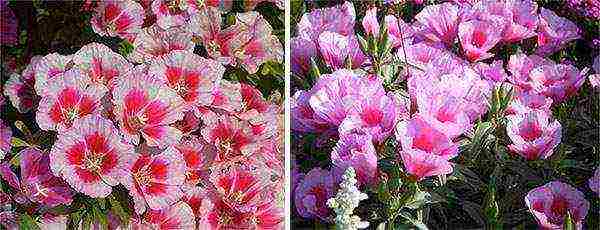
Godetia (Latin Godetia) refers to annual herbaceous plants of the fireweed family (Latin Onagraceae). On its squat branchy bushes, covered with lanceolate leaves, large numbers of brushes of large, bell-like flowers of various shades grow - white, peach, pink, scarlet, burgundy. Depending on the variety and type of godetia, it can be compact upright or, conversely, spreading. After flowering, fruit-"boxes" ripen, containing a large number of small seeds.
Gardeners in Europe and Russia fell in love with godetia for its amazing decorativeness, delicate, subtle aroma of vanilla and a very long (from July to October) flowering period and relative unpretentiousness.
Godetia can be successfully grown outdoors even in the northern regions of the country.
Outdoor and Popular Godezia Species
In total, there are about 20 species of godetia or "California rose" as it was called in its homeland. However, in our gardens you can find only two of them - large-flowered and adorable.
Large-flowered godetia (Latin Godetia Grandiflora), as the name of the species suggests, will delight you with large (up to 10 cm in diameter), luxurious flowers. Its sprawling bushes are not very tall and branch strongly. Some of the more popular varieties include:
- "Summer's Darling" (Sweet summer) - small, neat bushes, strewn with gorgeous burgundy pink flowers.
- "Orange Ruhm" (Orange Rum) - this variety differs from the previous one in greater stem height, but its reddish-orange flowers will be smaller.
- "Sybil Sherwood" (Sybil Sherwood) - low (no more than 40 cm), creeping on the ground bushes with bright pink flowers.
 D. Summer's Darling, G. Orange Ruhm, G. Sybil Sherwood
D. Summer's Darling, G. Orange Ruhm, G. Sybil Sherwood
- "Memoria" (Memory) - this variety differs from others in white flowers with a barely noticeable pinkish tinge.
- "Rembrandt" (Rembrandt) - a distinctive feature of the variety are double pink flowers with red spots. Godezia "Rembrandt" is very effective and extremely popular with gardeners.
- "Meteor" (Meteor) - very low bushes, covered with velvety dark scarlet bells.
 G. "Memoria", G. "Rembrandt", G. "Meteor"
G. "Memoria", G. "Rembrandt", G. "Meteor"
- "Maiden Blush" (girlish blush) - the cultivar is distinguished by white-cream flowers with a flash of bright pink hue at the base of the petals.
- "Orange Glory" (Orange glow) - large flowers, painted in pale pink
- "Satin Rose" (Satin rose) - medium-sized bushes with creamy pink flowers, the edge of the petal is slightly wavy.
 D. Maiden Blush, D. Orange Glory, D. Satin Rose
D. Maiden Blush, D. Orange Glory, D. Satin Rose
The lovely godetia (Latin Godetia Amoena), the second of the species grown in our country, has not so large flowers (about 4-5 cm in diameter), but the bushes are quite tall, elongated and not very branched. There are not so many lovely varieties of godetia as in the previous species. Some of them:
- "GraceRosePink" (Pink Grace) - a tall bush, strewn with bright crimson flowers.
- "Satin" (Satin) - a short plant with pink bells, the middle of the petal is a darker shade.
- "Scarlet Red" - red-pink flowers with a lighter center.
Some people mistakenly believe that there is also such a type as terry godetia. But in the botanical classification there is no such flower, this is nothing more than a simple property of some godetia hybrids. You can meet this feature in a number of the varieties listed above.
Quite often on sale you can find a mixture of various shades of the same variety. In this case, the prefix "Mix" is added to the variety name.
Godetia in landscape design
The location of the godetia when decorating your garden directly depends on which variety you have chosen. Tall bushes will look better in the central part of mixborders. Bells of salmon or purple color look great in a frame of pale pink, lilac or white flowers, so when decorating a complex flower bed with godetia, you should pay attention to irises or some types of asters.
Low shrubs are best used for flower borders that line lawns or paths. They are also ideal for decorating the slopes of alpine slides.
Neat little ridges will look very bright and elegant, on which several godetia bushes of different varieties are planted, or areas where godetia is adjacent to its kindred clarke.
Despite some capriciousness, godetia is strong and hardy enough, so you should not plant it next to weak plants. The best company will be unpretentious marigolds, peonies, Mexican ageratum or petunia.
Godetia grows well not only in the open field, but also in large dishes: flowerpots, boxes, pots. If desired, the annual can be grown in urban conditions, decorating both living quarters (balconies, loggias) and outdoor space (summer cafes, entrance groups, etc.)
High varieties of godetia are perfect for cutting, especially since the flowers do not wither in the water for 3 weeks.
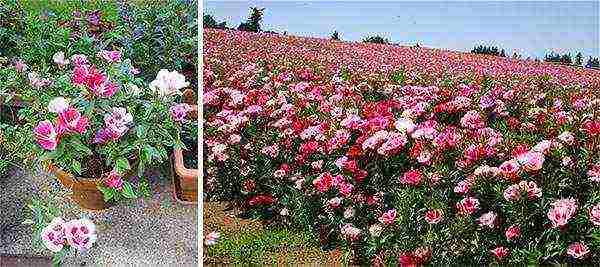
Planting godetia and caring for her
In general, as mentioned above, godetia is unpretentious, but there are still some features of caring for this bright beauty. The main attention of a gardener growing a flower in a personal plot should be given to the watering regime, lighting and fertilization of the godetia.
Location, soil
In the wild, the California rose usually grows in spacious, sun-drenched meadows, which must be considered before sowing it in your garden. She prefers loamy and humus soils with neutral or weak acidity. With an excess of alkali, urea, dolomite flour or peat should be added to the soil before planting godetia. Sandy soil and waterlogged areas on the banks of reservoirs are categorically not suitable for this flower.
It is best to plant godetia in sunny, wind-protected areas of the garden, but in the scorching heat, the bushes will need to be covered.
The plant also takes root in partial shade, and even in this case, the number of flowers will be sufficient, and their color is bright. The only thing you need to pay attention to is a more rare planting of bushes for good ventilation.
Sowing seeds, seedlings
Like most other annuals, godetia is usually propagated by seed. If you live in a relatively mild climate, they can be sown outdoors for the winter.In regions with severe weather, it is better to leave the sowing until mid-April-early May. At the same time, one should not be afraid of frost: paradoxically, the sun-loving godetia calmly tolerates temperatures up to 5 ° C below zero. By choosing this method of propagation, you will receive the first buds in early July.
You need to be extremely careful when choosing a site: an adult godetia may not tolerate transplanting, so it is sown either immediately in a permanent place, or in a street flowerpot, which can be easily moved around the garden if necessary.
First of all, the soil must be carefully dug up, loosened and watered abundantly. Humus (about 5 kg per 1 sq. M), mineral fertilizers and wood ash are also introduced into it. Immediately before sowing, shallow grooves should be made in the ground every 20-25 cm. In order for future seedlings to be healthy, the seeds are kept in a weak solution of potassium permanganate for about half an hour. When placing them in the ground, remember that the distance between adult bushes must be at least 25 cm, otherwise the plants will suffer from a lack of moisture and nutrition. If the sprouts grow too thick, they will need to be thinned out.
To protect the seeds from drying out, pecking out by birds and from attack by cruciferous midges, they are lightly sprayed with water from a spray bottle and covered with non-woven material.
When the godetia is planted in April, you will have to attend to the warming up of the earth. To do this, it is simply poured over with hot water or covered with a greenhouse film for several days. Seeds usually sown during this period also protect against environmental influences. All of these precautions will not be required in May.
After sowing, sprinkle the seeds with a very thin layer of earth and sprinkle them with warm water. In about two weeks, the first shoots will appear. If you regularly water the godetia, do not forget about weeding and loosening, by the middle of summer many bright bells will be interspersed in your flower beds.
Since the roots of the plant are very delicate and easily damaged when transplanting or picking, most gardeners prefer the sowing method. But for those who do not want to wait for the godetia to bloom for many months, you can start seedlings already at the end of March. Usually, only large-flowered godetia is propagated in this way, since it is more hardy.
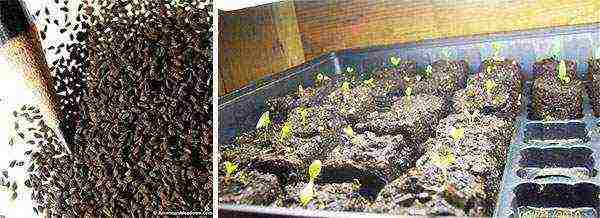
To do without unnecessary picks and thereby protect the roots of the plant, it is preferable to sow godetia in separate pots or cups with soil - several seeds each. Soil for seedlings can be prepared independently from the calculation: one part of river sand, one part of peat and one part of ordinary garden soil. Be sure to pour drainage on the bottom of the containers.
From above, the pots are covered with a film, which will need to be lifted briefly every day for airing. Watering at this time is best done very carefully, through a pipette. After 10-15 days, the first shoots will appear. Seedlings are fed every 10 days with a special liquid fertilizer for indoor seedlings.
Note that godetia grown from seedlings is generally weak and prone to a variety of diseases.
Landing in open ground: timing and technology
By the end of May, the seedlings will be sufficiently strong and ready for further growth in the open field. It is important not to miss the deadline - after the appearance of the peduncles, the godetia can no longer be transplanted.
The soil for the seedlings is prepared in the same way as for the seeds. Seedlings, which have already reached a height of 5-7 cm, are transferred to a flower bed together with an earthen clod: the bare roots of godetia, as a rule, leads to its death. Plants should be planted at a distance of about 25 cm from each other. White clay is sometimes added to the holes.
Remember that the scorching sun can kill sprouts that have not yet taken root, so planting should be carried out either in cloudy weather or in the evening, after sunset.
Water the seedlings abundantly.The ground around them will need to be regularly loosened and weeded to provide moisture and oxygen access.
In regions with a mild climate, godetia are sometimes planted before winter, so that the plant does not have time to ascend, but is only saturated with moisture. The top layer of the soil should freeze a little by this time. Since the seeds undergo natural stratification, the seedlings that have grown from them will be very hardy and will bloom two to three weeks earlier than usual.
Watering, feeding
Godetia is quite demanding about watering. She suffers both from excess and from lack of water. It is best to apply moderate but regular drip irrigation to the plant. Most likely, you will have to adjust to the godetia for some time and closely monitor its condition. To ensure that moisture is evenly distributed and it is easier for you to control the condition of the soil, regularly weed and loosen the soil next to the bushes.
Soak the water in the sun before watering to warm it up a little, especially if you are dealing with young plants.
For top dressing, apply complex fertilizers to the soil every three weeks. Godezia is very fond of a solution of nitrophosphate, which is prepared on the basis of one tablespoon for one bucket of water.
After the first buds appear, feed the godetia with any mineral fertilizers with a high content of phosphorus and potassium, which are called “For flowering flowers”. This will allow for the most active flowering.
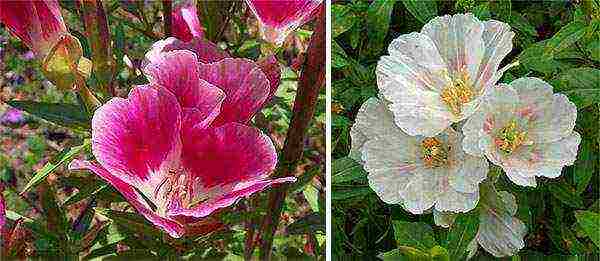
Fertilizers in which nitrogen predominates, on the contrary, will lead to excessive growth of green mass to the detriment of flowering. Many gardeners feed the soil with organic matter, mullein or bird droppings, which also leads to wild godecy blooms.
Trimming and shaping
In order to stimulate the emergence of new buds, it is not at all necessary to prune branches, it is enough just to regularly remove wilted flowers. The decorative shape of godetia is rarely given, since this procedure can damage delicate shoots.
High varieties of godetia (from 60 cm and above) require support, be sure to tie them to pegs, otherwise the fragile stems of godetia may break under the weight of flowers.
Post-flowering care, seed collection
In place of wilted godetia flowers, small tetrahedral capsules with small brownish-gray seeds remain. Mature boxes acquire a dark gray color (this usually happens in October), after which they can be cut and dried.
In the case when the godetia has already faded, and the fruits are not yet ripe, you need to carefully pull the bushes out of the ground, shake off the soil from the roots, tie the plants into bunches, put on a bag on each of the bunches and put on ripening.
Later, dry capsules are opened and seeds are removed, which retain their germination capacity for up to four years.
Pests and diseases of godetia
Fungus or excess moisture can lead to root rot. The appearance of this disease is usually indicated by the lethargy of the plant, wilting, dryness or brown spots on the leaves. Unfortunately, the affected bush can no longer be saved; it must be immediately removed from the flower bed in order to prevent further infection. Remember to sterilize your instruments after this procedure.
Sometimes godetia is affected by powdery mildew (peronosporosis). To get rid of it, spray the plant with fungicides.
Certain leaf-eating insects, for example, aphids, pose a certain danger to godetia. Any insecticide will help you to fight them. Remember that this problem usually occurs in unkempt, weedy beds or when godetia grows next to melons.
***
Of course, it will take you some time to adjust to all the whims of this beauty, but you will never regret the effort spent. The California rose will decorate any area and will delight you with its magnificent bright flowers until the very frost.
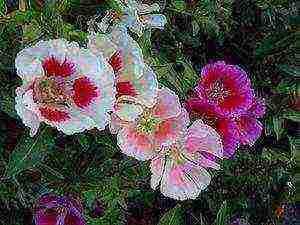 If you are breeding flower houseplants, you will agree that a flower garden will look incomplete without flowering plants. Still, what flowers with an abundance of choice to fill your home summer flower bed with? As soon as you ask yourself about this, willy-nilly, you think about godetia. This is a graceful and unpretentious flower that thrives in temperate climates.
If you are breeding flower houseplants, you will agree that a flower garden will look incomplete without flowering plants. Still, what flowers with an abundance of choice to fill your home summer flower bed with? As soon as you ask yourself about this, willy-nilly, you think about godetia. This is a graceful and unpretentious flower that thrives in temperate climates.
In case you are still unfamiliar with godetia, here is a small reference: this flower is extremely similar to clarkia, but its flowers are larger and more catchy. The plant is native to North America and belongs to the species of herbaceous annuals.
Godetia can be used in various ways: for the design of flower beds, in single and mixed plantings, borders, for decorating balconies and for planting in outdoor flowerpots.
Outdoor cultivation
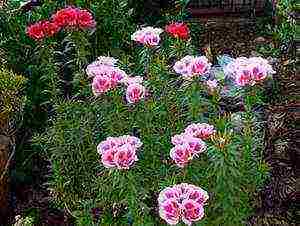 How to grow godetia? It is sown in open ground or, if necessary, apply early flowering seedling method... In the southern regions, flower seeds are sown even before winter. In addition, sowing on open ground is preferable, since, unlike seedlings, it eliminates the risk of damage to the plant during transplanting and picking.
How to grow godetia? It is sown in open ground or, if necessary, apply early flowering seedling method... In the southern regions, flower seeds are sown even before winter. In addition, sowing on open ground is preferable, since, unlike seedlings, it eliminates the risk of damage to the plant during transplanting and picking.
Sowing is carried out in open ground in the first week of May or at the end of April. Godetia begins to bloom in early July. For her, you need to select places with sufficient sunlight.
Preferable loamy soil... On sandy years it grows worse. On poor soil, it can be grown only with preliminary fertilization, constant watering and top dressing.
Before sowing, the soil must be dug up, loosened and watered. Humus (5 kg per meter), wood ash and mineral fertilizers are added.
It is necessary to sow in such a way that the godetia bushes are 20-25 centimeters apart. If the seedlings are densely packed, the seedlings must be thinned out. The grooves loosen shallow ones, with a distance of at least 25 centimeters between them.
Godetia seeds are quite small, so they do not need to be sprinkled with plenty of earth. After the end of sowing, the land is constantly watered. The water used for irrigation should not be cold, this will adversely affect the rate of emergence.
The sprouts will sprout within two weeks. The next care of the plant is watering, weeding and using fertilizers. The flower loves organic and mineral fertilizers in the soil, they can be added during watering, after dissolving in water. Liquid fertilizers such as Ideal are also suitable. It is necessary to carry out top dressing once a fortnight.
A clearing of blooming godetia will appear in your place in early July, and will delight the eye until late autumn.
Growing godetia using seedlings
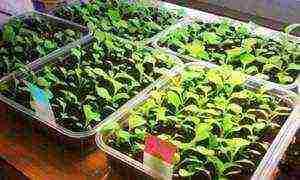 If you want to get the earliest godetia color, then the seeds should sow in boxes in early April or March. For sowing, you must choose nutritious and loose soil. The seeds will sprout in two weeks.
If you want to get the earliest godetia color, then the seeds should sow in boxes in early April or March. For sowing, you must choose nutritious and loose soil. The seeds will sprout in two weeks.
Picking carried out in the presence of two leaves in separate pots. Please note that picking and replanting badly affects godetia, as a result of this, it must be done extremely carefully, protecting the roots. It is much better to grow flowers without using picks, sowing several seeds in pots, for a possible selection of a more established plant.
When planting in a flower bed, the distance between the godetia bushes should be at least 25 centimeters. It must be planted quite carefully, trying not to damage the lump of earth on the roots. The sprouts are fertilized every two weeks.
When growing godetia, pay attention to:
- correct watering - the flower does not tolerate waterlogging and will not grow on dry ground. Watering godetia is necessary in accordance with the weather and soil condition;
- godetia has a negative attitude towards overheating, in the heat it is preferable to shade it;
- sprouts often infect leaf-eating insects, so you need to look after this from time to time and, if necessary, process it in time;
- remember about fertilizers, in order for godetia to have abundant flowering, it must be fertilized a couple of times with the full composition of the necessary mineral fertilizers;
- remember, by eliminating faded inflorescences, you enable the plant to extend the flowering period.
How to collect godetia seeds
Godetia seeds ripen for 30 days in the last days of the plant's flowering. As soon as the capsules begin to darken, they are cut off, dried, later opened and the seeds are shaken out. It is possible to sow them closer to winter if you live in the south, or save them until the coming spring. Godetia seeds keep their germination capacity within four years.
Varieties and types
Godetia grandiflorum

The stems of the godetia bush reach a height of 20-40 centimeters, they are erect or recumbent, fragile, lignified by the end of the growing season. Leaves are lanceolate, tapering towards the base. Large, up to 10 centimeters in diameter, cupped or bell-shaped, at the ends of the shoots are collected in leafy brushes. Silky petals are colored pink, red, crimson, snow-white, lilac, scarlet. Blooms in July and blooms until October. This species forms the basis of the tall and dwarf hybrid varieties used for curbs. Famous varieties:
- «Weiser Schwann"- a spreading, undersized bush, 30-35 centimeters high, with greenish shoots at the top and brown at the base. It has wide lanceolate leaves and satin-white cupped flowers, with whole petals, 5-6 centimeters in diameter;
- «Orange Room"- semi-sprawling, medium-sized branched variety 40-50 centimeters high, with reddish-green shoots and whole petals.
Dear godetia
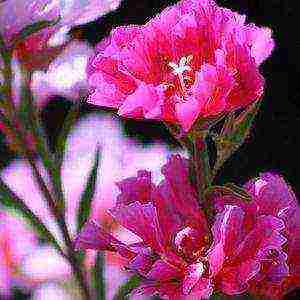 Shrub plant 60 cm tall, with erect, smooth stems, fragile and woody by the end of the growing season. Narrow-lanceolate, pointed leaves are bell-shaped or cupped, flowers up to 5 centimeters in diameter with satin spatulate petals, crimson-lilac, red-pink or various shades of red. The flowering period is from early July to September. Popular varieties:
Shrub plant 60 cm tall, with erect, smooth stems, fragile and woody by the end of the growing season. Narrow-lanceolate, pointed leaves are bell-shaped or cupped, flowers up to 5 centimeters in diameter with satin spatulate petals, crimson-lilac, red-pink or various shades of red. The flowering period is from early July to September. Popular varieties:
- «Kirshkenigin»- a variety with characteristic pinkish-red flowers;
- «Crystal snowflake"- a variety with a high stem with snow-white flowers.
Terry godetia
Hybrids of large-flowered godetia often have double, semi-double and densely double flowers.
Terry godetia azalea has excellent varieties:
- «Cybil Sherwood"- small bushes 30-40 centimeters tall with lanceolate leaves and greenish shoots with a pink tint. Semi-double flowers of a pinkish-salmon shade with petals evenly lightening from the middle to the edge, 5 centimeters in diameter;
- «Rembrandt"- low hemispherical bushes 30-35 centimeters high with pink-green shoots and narrow-lanceolate leaves. Double pink flowers with a reddish speck on a wavy petal cut along the edges, 5-6 centimeters in diameter;
- «Diamond»- bright red flowers with snow-white spots;
- «Bride"- double, azalea-shaped flowers of snow-white color with a slightly visible pink tint, belonging to the Cyprian family.
And finally, tall varieties are suitable for bouquet cutting. Her flowers are harmoniously combined with other annuals, the combination with clarke is especially incomparable!
Believe me, those worries and troubles that the plant requires are more than repaid. This gorgeous flower is definitely worth growing!
Different varieties of beautiful godetia
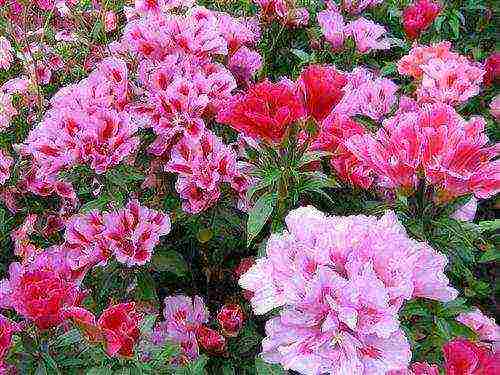 Godetia (Godetia) belongs to the genus of herbaceous plants and the family of fireweed. The flower is very close to the genus Clarkia.Grown in the open field and at home.
Godetia (Godetia) belongs to the genus of herbaceous plants and the family of fireweed. The flower is very close to the genus Clarkia.Grown in the open field and at home.
Godetia: botanical features of the plant
The stem part is erect, branched, with a height of 20-60 cm. The above-ground part forms neat attractive bushes of a spreading or pyramidal shape. The foliage is alternate, lanceolate and whole-edged. Flowers bell-shaped or cup-shaped, rather large in size, with a diameter of 3-10 cm. Flowers are simple or double type, four-petal, collected in racemose inflorescences.
The color of the flowers is white, red, carmine, peach, pink, purple or combined. Peduncles are short. The fruits are represented by a tetrahedral cylindrical box in which small seeds ripen, which remain viable for three to four years. Hybrid forms are also popular in culture: azalea, dwarf and terry, bushy and large-flowered.
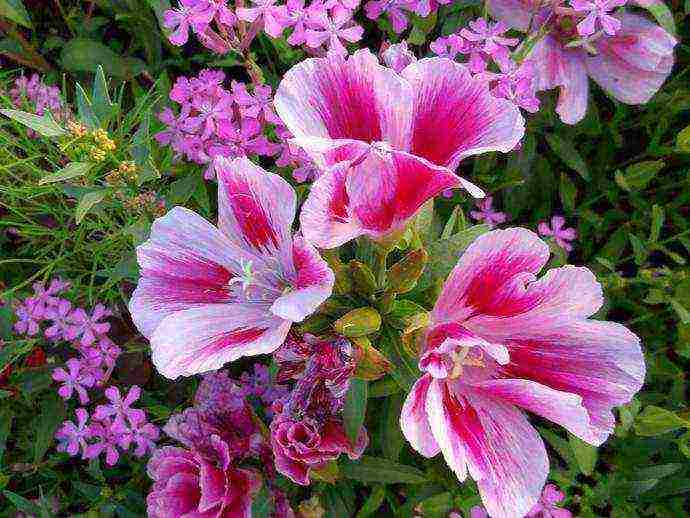
Types and varieties of godetia
About twenty species are known that grow mainly in North and South America, in California. Forms and varieties can differ in the height of the aboveground part, as well as the type and color of the flower. To grow the species in the garden, flower beds and flower beds, ridges and containers are used. Godetia flowers are open in any weather, and also do not lose their decorative effect at all until withering.
Also read: Pinnate carnation: rules for planting, growing and care

Godetia azalea flower
This variety is the most persistent and is able to easily endure even relatively hard frosts. The most popular undersized variety is "Monarch"... Flowers are bell-shaped, with stems no more than a quarter of a meter high. Delicate petals in attractive pink tones.
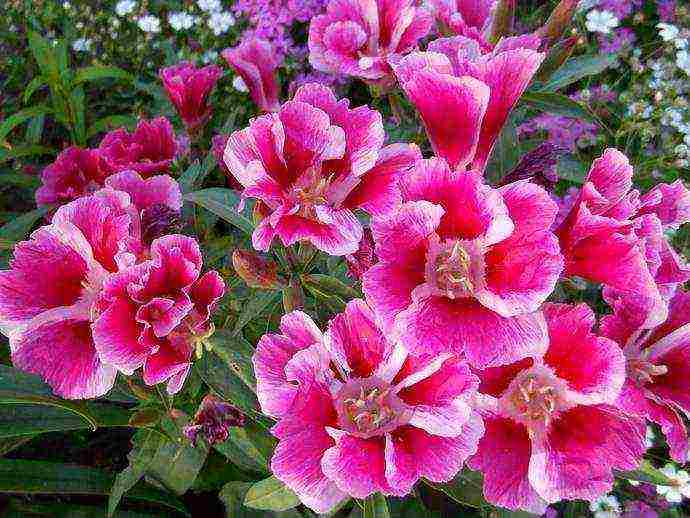
G. lovely
The adorable (G.amoena) is represented by several garden forms and varieties of an annual ornamental plant with a straight-growing branchy stem part no more than 30-60 cm high. The petiolate foliage is arranged alternately. A significant part of the varieties form double flowers with a diameter of up to 50-80 mm. Flowers of regular shape, collected in racemose inflorescences. The most popular varieties:
- "Kirshkenigin" with reddish-pink flowers;
- Rosea with delicate pink flowers and a purple base;
- "Crystal snowflake" with a high stem and snow-white simple flowers.

G. terry
In natural conditions, such a species does not exist. It is represented by hybrid varieties with semi-double, double and double flowers in different shades:
- "Orange glory" with silky flowers;
- "Maiden Blush" with a compact overhead part;
- Summer's Kiss with red and pink flowers;
- "Beauty" up to 30-45cm high, with delicate, silky, red double flowers.
Growing godetia from seeds: when and how to plant a flower correctly
Proper cultivation from seeds is the only way to propagate an ornamental flowering crop. In most regions, it is customary to plant a plant with seedlings.
For growing seedlings, you can purchase a ready-made soil substrate., but you can also use a self-prepared mixture based on loam with a small amount of wood ash. The self-prepared soil substrate must be thoroughly decontaminated by heating it for half an hour in an oven at a high temperature. A good result is obtained by disinfection with a solution of potassium permanganate.
To get the earliest flowering, the seeds are sown at the very beginning of spring. Typically, the average seed germination time is a couple of weeks. Domestic amateur flower growers practice both surface sowing of seed material and some deepening of seeds.In order to create the most comfortable conditions for the emergence of seedlings, a film coating of crops is used. Irrigation activities are carried out as needed. After the emergence of mass shoots, the film is removed. If the crops are too thick, thinning is performed.
How to plant godetia seeds (video)
Experienced florists recommend diving seedlings... Transplantation into separate seedling containers is carried out after a pair of true leaves have formed on the seedlings. The root system of the seedlings is quite fragile and delicate, so care must be taken when transplanting. It is best to use regular small peat pots for growing seedlings. Seedling material must be fed every ten days with mineral fertilizers.
A couple of weeks before planting flower seedlings in a permanent place, you need to start hardening activities. Planting in flower beds or flowerpots is made after the threat of late spring frosts has passed, from about the second half of May. The optimal distance between the planted plants is a quarter meter or slightly less.
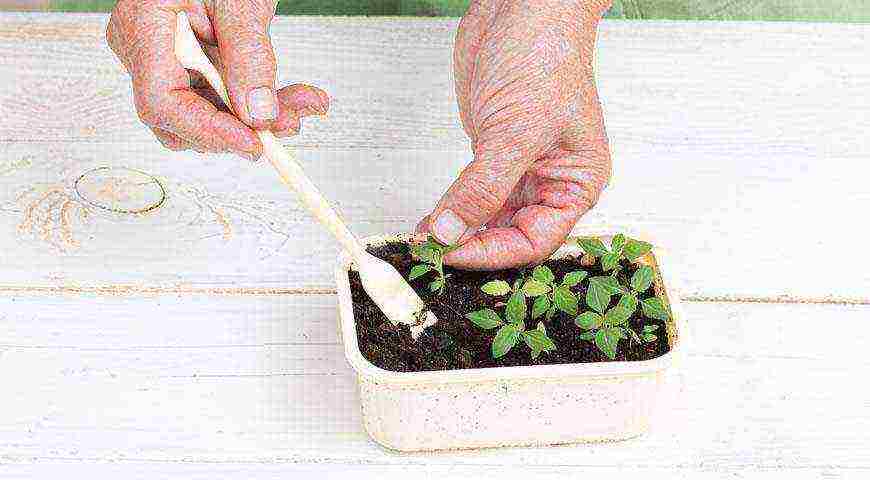
Sowing in a permanent place in flower beds is done around the end of April or in the first decade of May. Areas with loamy soils are best suited. Should be consideredthat the seedlings tolerate low-temperature conditions well, and that is why direct sowing in open ground is allowed. However, in order to enjoy abundant and vibrant flowering for a long time, it is recommended to give preference to the seedling method of growing.
When growing outdoors, special attention should be paid to moderate irrigation measures, to provide the culture with slight shading, as well as to make timely inspections and carry out preventive spraying. To prolong flowering and make it more lush, it is required to regularly carry out top dressing with complex removals, as well as systematically remove all already faded and wilted flower stalks.
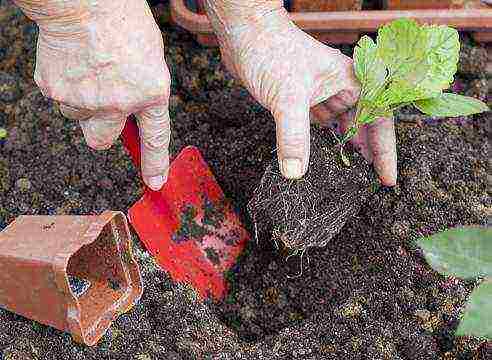
Godetia: planting and care at home
Godetia can be grown quite easily in indoor floriculture, but due to the relatively long stem part, the plants do not always feel comfortable on the windowsills. For growing at home, it is best to give preference to undersized varieties and a compact form of the aboveground part. Such varieties form rather large flowers with a diameter of up to 60 mm, growing in an upright position, and the inflorescences consist of wavy or slightly cut along the edges of the petals.
Planting in indoor culture is done in the spring. Immediately before sowing, in order to protect future seedlings from damage by pathogenic microflora, it is necessary to keep the self-collected seed material for half an hour in a weak solution based on potassium permanganate. You can sow seeds without sprinkling with soil., but in order to minimize the risk of drying out, it is best to sprinkle them with a thin layer of soil. In the first days, it is necessary to ensure the greenhouse effect for crops, and irrigate only with warm and well-settled water, spraying it from a finely dispersed spray bottle.
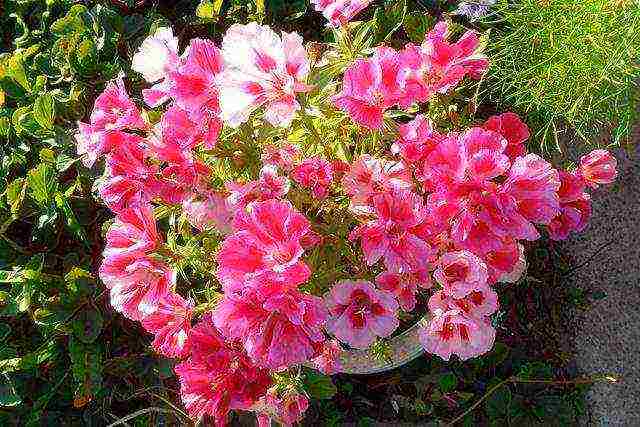
Caring for a room goddess is not difficult, and consists in the implementation of the following mandatory activities:
- any types and varieties of ornamental crops are very responsive to regular irrigation activities. For irrigation, settled soft water at room temperature is used. It must be remembered that excessive application of water and accumulation of moisture, as well as strong drying of an earthy clod in a flower pot, is very difficult for the culture to be tolerated and can cause death;
- when growing tall, straight-growing varieties, tying is necessarily used or a support is used;
- in order to stimulate long and abundant flowering, it is very important to feed the indoor flower a couple of times a month with complex fertilizers with a low content of nitrogen components;
- after watering, it is allowed to shallow the soil in a flower pot, which improves the air permeability of the soil.
In order to prevent and treat fungal infections, special chemical preparations are used in a dilution recommended by the manufacturer.
Features of growing godetia (video)
How beautiful to plant and grow godetia outdoors
Godetia is actively used for growing in all types of flower beds and flower beds. A beautifully flowering culture is planted in an ordinary way one by one, and in groups, which allows you to get bright and spectacular spots in the flower garden being decorated. When planted in a mixed bed, tall godetia is placed in the central part of the flower garden, and dwarf varieties and forms look best closer to the edges.
The culture is optimal for growing in garden pots, and is used as an unpretentious but very effective decoration of balconies with hanging baskets. Large-flowered godetia is distinguished by good bushiness, therefore, when planting in a container, the stem part lays down and hangs beautifully under its own weight. It goes well with small-flowered ageratum, lobelia, gatsania and escholzia. Low decorative leafy cineraria and Byzantine stachis can serve as a good frame. They stand in a bouquet cut for a very long time.
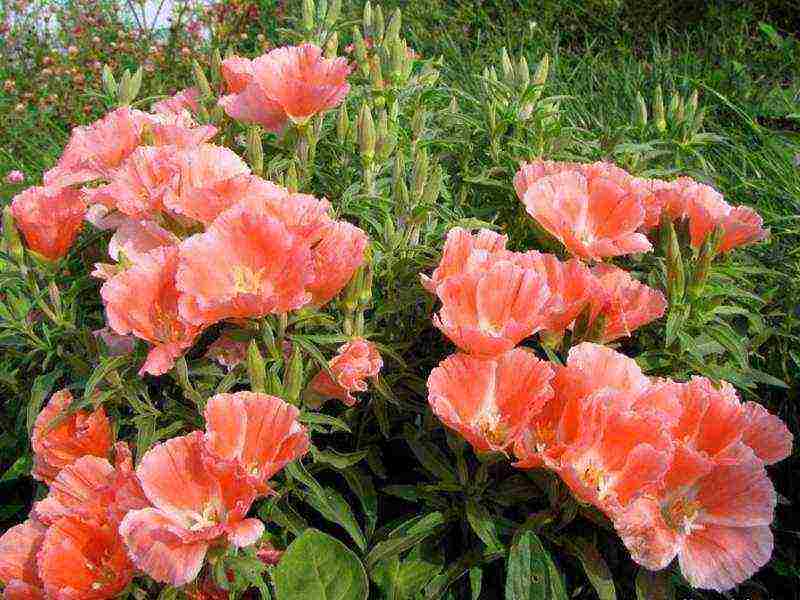
Rules for collecting and storing seeds
Godetia of any species and variety is propagated exclusively by seed. Seed material ripens within a month after flowering. As soon as a pronounced darkening of the seed pod is noted, they must be carefully cut, dried, and then carefully opened and shaken out the seeds on a prepared sheet of white paper.
Self-collected seed material can be sown in the southern regions of our country before winter. In areas with insufficiently favorable soil and climatic conditions, it is required to store seeds until next spring. Godetia seed germination rates persist for three to four years.
Godetia: varieties (video)
Due to its high decorative properties and unpretentiousness, godetia has become very popular among domestic gardeners. The graceful plant is planted in flower beds, mixborders, rabatki and is used in groups. Low-growing varieties look great on balconies, in outdoor flowerpots and in pot culture, while tall, upright forms are ideal for bouquet cutting.
Attention, only TODAY!
Reviews and comments
Did you find a mistake in the text? Please select it and press Ctrl + Enter. Thank you!
Rating:
(
estimates, average:
out of 5)
Delicate, graceful godetia, accustomed to the mild California climate, surprisingly, has perfectly taken root in our temperate latitudes. A fragile and defenseless-looking plant is capable of growing a strong compact bush in a season, dotted with satin flowers of amazing shades
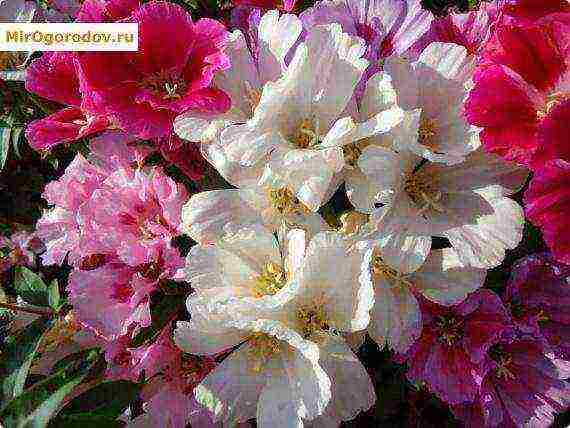
Southern beauty in northern latitudes
If your garden lacks bright spots, solar godetia will do the job just fine. It will decorate a flower bed or a rabat, it will look great in a mixborder, it will transform a balcony or loggia.
An American guest who has become her own
The godetia plant belongs to the Cyprus family. In Europe, it gained recognition as a garden flower in the middle of the last century, having arrived there from Southern California. Since then, many new cultivars and plant hybrids have been bred - with increased decorativeness and adapted to cool weather conditions.
This is a herbaceous annual, erect stems, form a neat pyramidal bush up to 0.6 m high. There are low-growing varieties (up to 20 cm) with a creeping stem.Twigs of godetia, juicy and brittle at the beginning of the growing season, become woody by the end of flowering. Flowers resemble bells in shape, there is something in common with azalea, at the top they are collected in large brushes. A bright, rich palette delights - spatulate petals of all shades of red, lilac, pink, with white strokes and a silky, slightly corrugated texture create the effect of multi-colored lace.
It is interesting! The annual blooms from 2 to 4 months, producing an incredible amount of flowers, because each of them lives no more than 3 days. Exudes a vanilla aroma that is enhanced by cutting.
In our gardens, godetia is more often represented by large-flowered varieties, although the cultivation of border options with small inflorescences, from the point of view of landscape design, is no less interesting.
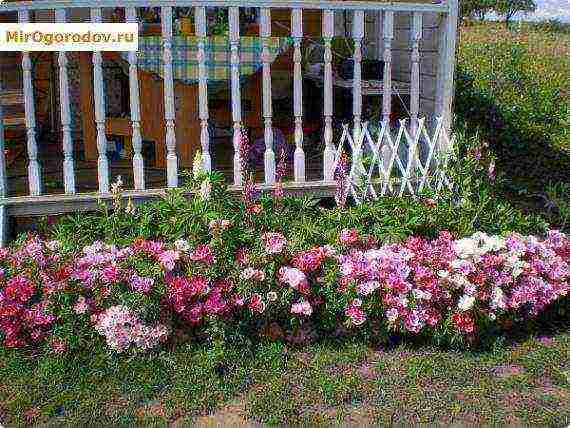
The variegated palette of colors radiates warmth, gives a sense of celebration
Planting methods
Growing godetia at home is easy. Based on the climatic features of the region, they use different planting methods - direct spring or winter sowing of seeds into the ground, through seedlings. Early spring sowing and seedling planting provide faster plant development and a longer flowering period - from July to autumn frosts.
Sowing in open ground
Annuals, as a rule, are unpretentious, but they like to have a lot of sun. Godetia flowers are no exception. Choose for sowing a bright corner of the garden with fertile soil, well aerated and permeable, since the plant does not tolerate stagnant moisture. Before planting, the soil is loosened, if necessary, humus is applied, complex mineral fertilizers such as nitrophoska (100g / m²).
Regardless of whether seeds are sown in open ground or for seedlings, they must first be prepared.
- To stimulate germination, heat treatment is used - a bag of seeds is immersed in hot water (45-50⁰C), after cooling, it is laid out on a damp cloth, covered with a wet napkin on top and left for a day.
- Disinfection is carried out using a weak solution of potassium permanganate - the seeds are placed in it for 20 minutes. As a dressing agent, you can use a foundation.
- To accelerate seed germination, to obtain strong, healthy seedlings, humic preparations are used - Epin, Potassium humate.
When grown by direct sowing from seeds, godetia is sown in April - May, when the soil warms up to 6–10⁰. The grooves for the seeds are made shallow, you can do without them, since the planting depth does not exceed 0.5 cm. Before sowing, the soil is well moistened, the filled rows are covered with a dry substrate. The interval between adult plants should be 20–25 cm, but the seeds are sown denser, with the expectation that some of them will not sprout, some seedlings will die or be weak.
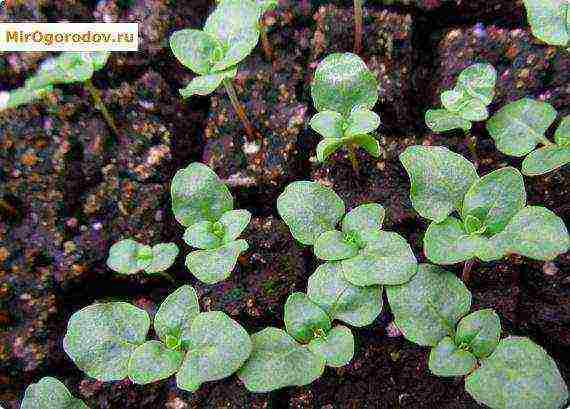
Growing flowers by sowing seeds in the soil
Growing through seedlings
Godetia seedlings are sown in March in a greenhouse, greenhouse, on a windowsill. Low boxes, cassettes, flower pots are filled with a soil mixture consisting of peat, humus, leafy earth. The sown seeds will sprout in about 2 weeks. At the stage of appearance of 1-2 leaves, they are dived into individual cups, 2-3 pieces each. The plant tolerates diving painfully, so be prepared for the fact that some of the seedlings will not take root. Watered without fanaticism so as not to overmoisten the seedlings with warm water.
Seedlings are planted in open ground in May, when they reach a size of 5–7 cm, always with a damp clod of earth. The distance between plants is 25 cm in rows or in planting in groups.
Note! The delicate petals of an annual are sensitive to excessive irrigation; under the influence of prolonged rains, the flower sags, loses its shape. In regions with rainy summers, godetia is best grown in mobile containers and flowerpots.
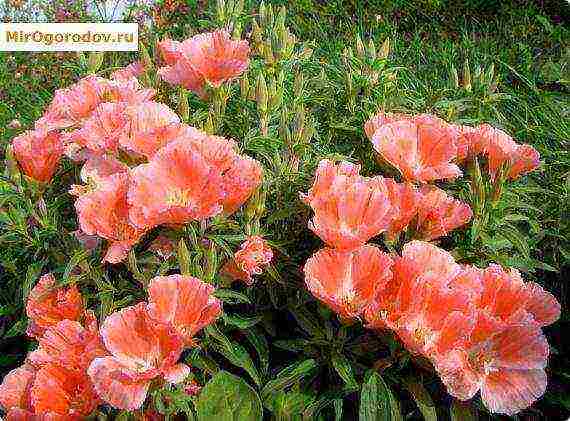
A graceful summer plant will delight with bright colors until late autumn
What you need to know about boarding and leaving?
As a whole, a rather unpretentious plant, godetia has a number of features in the agricultural technique of planting and care.
The annual is sensitive to the cleanliness of the soil, loves weeding, loosening. Flower beds overgrown with weeds attract leaf-eating insects, flowers are poorly ventilated, all this negatively affects their growth. When the shoots of aphids are damaged, earthen fleas are sprayed with insecticides.
The plant loves water, but reacts negatively to waterlogging and poor aeration of the soil. Watering is needed regularly, followed by loosening. It is best to be guided by the weather, to make sure that the soil surface does not dry out.
In order for the flowering to be plentiful, and the flowers to be large, rich in color, 2-3 additional dressings are needed during the active growing season. A good effect is given by complex fertilizers containing three main elements (NPK) - nitrophoska, azofoska. Flowers love liquid dressings with the addition of trace elements and humic substances, such as Rokogumin, FERTimix, Clean Leaf Success.
Large-flowered godetia lends itself well to formation. To make the bush lush and compact, and the stems do not fall apart, pinch the main shoot at a height of 30-40 cm. Tall species need a garter. Removing the ovary formed after flowering stimulates the formation of new buds and flowers.
Popular species and varieties
Of the 20 cultivated species, large-flowered godetia with regular or double flowers and lovely ones with a lush inflorescence on a long stem are widely used in ornamental gardening. The latter variety is good for cutting.
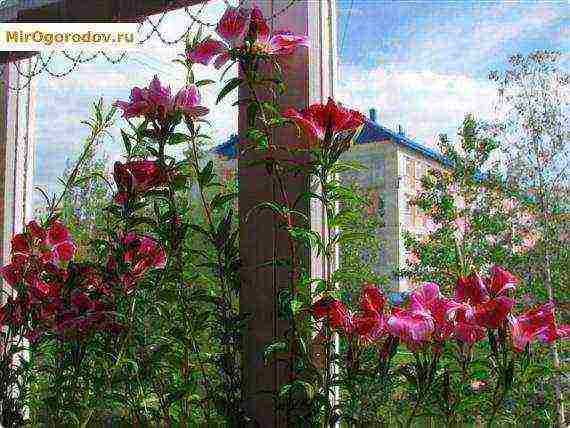
Growing adorable godetia on the balcony
Several groups are leading in the rating of the most popular varieties.
- Godetia varieties Rembrandt, Meteor, Brilliant are low (30–40 cm), semi-spreading bushes. The flowers are large, 7-10 cm in diameter, double, azalea. Used in groups and as border flowers, they are distinguished by long flowering.
- Hybrid Orange Rum with a fairly tall stem and medium-sized flowers attracts with a rich orange-red color.
- Godezia Monarch is a dwarf ornamental bush (20 cm) with beautiful bell-shaped flowers and various colors, indispensable in mixborders, for decorating balconies.
Amateur gardeners and landscape design specialists appreciate the decorative annual for its elegance, long flowering, endurance and unpretentiousness. You will love it too.
Moscow, Russia, on the site since 11.01.2017


